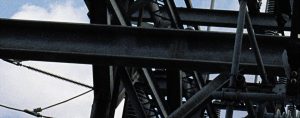| High Voltage
 We all need another place. What I call another place is that alternate, illusory location, to which we only arrive through one of memory’s shortcuts. Its origin can be found in our diurnal hallucinations. My other place is not necessarily a home, a place that provides contention and shelter, but a territory I need to rediscover every time I begin a new body of work –and this without me having any particular purpose of staying in that closed domain. The constant changes in my real, geographical whereabouts, have caused in me the urge of delving into the subject of mobility, always from the perspective of that other place. Which is probable where dwells the thing most important for us: stability. We all need another place. What I call another place is that alternate, illusory location, to which we only arrive through one of memory’s shortcuts. Its origin can be found in our diurnal hallucinations. My other place is not necessarily a home, a place that provides contention and shelter, but a territory I need to rediscover every time I begin a new body of work –and this without me having any particular purpose of staying in that closed domain. The constant changes in my real, geographical whereabouts, have caused in me the urge of delving into the subject of mobility, always from the perspective of that other place. Which is probable where dwells the thing most important for us: stability.
 The other place that I decipher, that I interpret for this exposition, is built from within the attraction that grids exert on me. They fascinate me. Our sight is capable of creating them, hovering over the electrical power stations: nets woven instantly as a consequence of the perspective our gaze imposes on the cables and metallic structures, the dispensers of high voltage. These are strange and inaccessible places, raised on an intriguing scale. Zones we all see, but inhabited by no one. Their presence is foreign, so to speak –even if it is well incorporated into our day-to-day perception. Unless, of course, we start reading them aesthetically, which is one of the ways I take to approach this matter. The other place that I decipher, that I interpret for this exposition, is built from within the attraction that grids exert on me. They fascinate me. Our sight is capable of creating them, hovering over the electrical power stations: nets woven instantly as a consequence of the perspective our gaze imposes on the cables and metallic structures, the dispensers of high voltage. These are strange and inaccessible places, raised on an intriguing scale. Zones we all see, but inhabited by no one. Their presence is foreign, so to speak –even if it is well incorporated into our day-to-day perception. Unless, of course, we start reading them aesthetically, which is one of the ways I take to approach this matter.
These mysterious industrial sites, these forbidden areas, stir up in me an impulse, the drive needed to transform pure visual enjoyment into the object of an installation. These worlds of fiction – for those of us who are not engineers – have been designed to transmit currents and signals, and they charge my nuclei of attention, lending me a sensitive material to which I give order and sense. It is then when I put aside what is known to me – the colour – and take up a tool from 1956, the Leica M3, an analog camera that I recover over three decades later to discern that other place with photographic precision, focusing and reinterpreting an elusive, unstable, altered reality. With her on my hands, I build a work of spatial and monochrome vocation.

The precedents of this new work are two previous installations, both of recent date. The first one was entitled Grilla, and it took place at Galería GBG, Caracas, in 2012, as part of the solo exhibition entitled El color como estructura (Color as structure). The second one, Grid, from 2013, is a piece of the same nature, currently exhibited in a private collection located in Coral Gables. But the new work reveals itself deprived of those luxurious masses of colour that define my toil since 1983. On the contrary, now I wish to observe the economy of visual elements, barely connecting the lines, their joints and fractures, their directions, allowing the virtual areas derived from this process to remind us – given their orthogonal configuration – of electric systems.
High Voltage gathers all those suspended, aerial lines that up high serve as a pathway for particles to travel from one place to another, generating a flux of electrons, forming closed circuits: a metaphor for the aesthetic proposal that is taking place in this room. A continuum strings together each of these four installations which, through a diversity of linear elements and using different scales, materials, supports, tones, establish among each other a steady transmission of meanings, of content. The savage energy, conducted and controlled by these strange, reticular machines, unfolds eagerly in all of the present works, springing from the same original impulse: the use of the recovered camera.
Patricia Van Dalen, August 2013 |